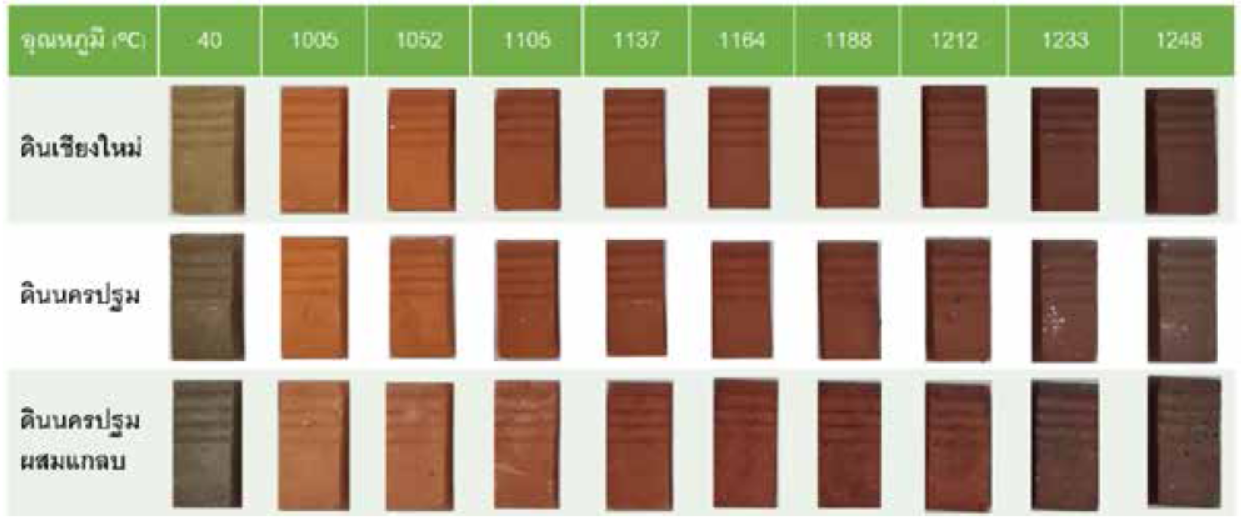A study of Nakornpathom red clay body for application in ceramic products
DOI:
https://doi.org/10.60136/bas.v12.2023.367Keywords:
Red clay, Stoneware, Ceramic, NakornpathomAbstract
This research aimed to develop red clay body which was used for stoneware production in Nakornpathom province. The body should have high fired strength, closed to the body strength used in current stoneware production which would be strong enough for forming and handling. The research was carried out by a selection of raw materials: Nakornpathom red clay and Sieved-Nakornpathom red clay, compared the results with Chiangmai commercial clay. The clay slap was pressed into the square-shape mold and the green samples were then sintered at a range of 1005 to 1248 oC. Colour, phase information, chemical composition, flexural strength, hardness, water absorption, shrinkage and thermal expansion were determined. The results revealed that the properties of Nakornpathom red clay can be developed for use in the stoneware industry. The water absorption rate of Nakornpathom red clay was less than 3% when applying the appropriate firing temperature between 1105 to 1200 oC. After firing, Nakornpathom clay showed red brown in color (L* a* and b* values were 34.84 20.22 and 34.81, respectively) with water absorption rate of 0.00%. Nakornpathom red clay and Chiangmai commercial clay presented no difference phase composition which contain quartz, cristobalite, mullite and hematite. The flexural strength of Nakornpathom red clay was 39.08 N/mm2 which was higher than Chiangmai commercial clay (22.58 N/mm2). The thermal expansion coefficient of the clay body was slightly higher than W31 clear ceramic glaze. The glazing ceramic prototype made from Nakornpathom red clay showed high flexural strength with no visible crack.
References
ปรีดา พิมพ์ขาวขำ. เซรามิกส์. กรุงเทพฯ: โรงพิมพ์จุฬาลงกรณ์มหาวิทยาลัย; 2547.
ไพจิตร กิ่งศิริวัฒน์. เนื้อดินเซรามิก. กรุงเทพฯ: โอเดียนสโตร์; 2541.
Dodd AE. Dictionary of ceramics. 3rd ed. London: The Institute of Materials; 1994.
โกมล รักษ์วงศ์. วัตถุดิบที่ใช้ในงานเครื่องปั้นดินเผาและเนื้อดินปั้น. กรุงเทพฯ: วิทยาลัยครูพระนคร; 2531.
Boch P, Niepce JC. Ceramic materials. Great Britain: John Wiley & Sons; 2007.
ทวี พรหมพฤกษ์. เครื่องปั้นดินเผาเบื้องต้น. กรุงเทพฯ: โอเดียนสโตร์; 2523.
สำนักงานมาตรฐานผลิตภัณฑ์อุตสาหกรรม (สมอ.). มาตรฐานผลิตภัณฑ์อุตสาหกรรมภาชนะเซรามิกที่ใช้กับอาหาร: สโตนแวร์. มอก. 602-2546 กรุงเทพฯ: สมอ; 2546.
ASTM International. Standard test method for drying and firing shrinkages of ceramic whiteware clays. ASTM C326-09(2018) [Internet]. 2019 [cited 2023 Feb 28]. Available from: https://www.astm.org/c0326-09r18.html doi: 10.1520/C0326-09R18
Somrang P, Wannagon A, Sornlar W, Choeycharoen P, Prasanphan S, Shongkittikul W. Lampang raw material characterization to assess the suitability for ceramics industry. Key Eng Mater. 2016;690:187-93.
ทนารัช จิตชาญวิชัย. ขี้เถ้าแกลบแทนซิลิกาสำหรับผลิตภัณฑ์เซรามิกอุณหภูมิ 1200 องศาเซลเซียส [อินเทอร์เน็ต]. 2558 [เข้าถึงเมื่อ 21 กุมภาพันธ์ 2566]. เข้าถึงได้จาก: https://so06.tci-thaijo.org/index.php/vrurdistjournal/article/view/44814
สุทธิชัย ทีปประสาน. เทคนิคการทำเคลือบลายคล้ายผลึก [อินเทอร์เน็ต]. 2538 [เข้าถึงเมื่อ 17 ตุลาคม 2565]. เข้าถึงได้จาก: http://lib3.dss.go.th/fulltext/dss_j/2538_43_137_p3-4.pdf
ธมลวัฒน์ หิรัญชาติอนันต์. ผลของค่าสัมประสิทธิ์การขยายตัวทางความร้อนของดินขาวลำปางที่เติมวัตถุดิบกลุ่มฟลักซ์ต่างกัน [อินเทอร์เน็ต]. 2560 [เข้าถึงเมื่อ 22 กุมภาพันธ์ 2566]. เข้าถึงได้จาก: https://ejournals.swu.ac.th/index.php/SWUJournal/article/download/9561/8149/28262

Downloads
Published
How to Cite
Issue
Section
License
Copyright (c) 2023 Bulletin of Applied Sciences

This work is licensed under a Creative Commons Attribution-NonCommercial-NoDerivatives 4.0 International License.









